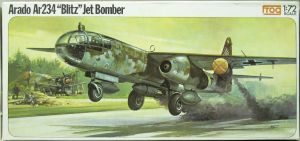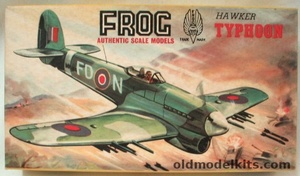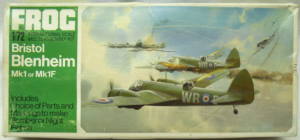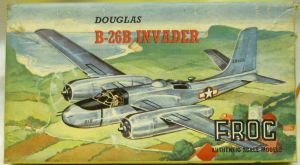Frog Model Kits
Frog Junkers JU-87G Stuka - Hungarian Air Force or Hans Rudel, 1/72, F181
Plastic Model Kit, Box Condition: Good

$18
This 1970s issue includes markings for Stab/Stukageschwader 2 Hans Rudel and Hungarian 102/1 Dive Bomber Squadron (1943). Inventoried 100% complete with all parts decals and instructions. Frog is considered the father of injection molded model kits. Frog is considered the father of injection molded model kits. The Lines Brothers opened Frog in 1932, capitalizing on the fever caused by Lindberg's solo transatlantic flight. Almost overnight the western populations became 'Air-Minded', and anything aviation was in high demand. Frog created a quality line of stick and tissue rubber powered aircraft and gliders as well as innovative ready-to-fly rubber powered aircraft that required no assembly. The box even contained a built-in rubber motor winder and fuselage holder. Model airplane flight competitions were popular in Great Britain, and one category was 'Rise Off the Ground', or ROG. By changing this to 'Flies Right Off the Ground', the FROG name was born. In 1936 Frog created a line of injection molded plastic models, the first such kit line in the world (Hawk sold a line of injection molded aircraft models in 1934 but they were factory assembled and painted). Named 'Penguin' after the bird that does not fly, the kits were innovative beyond the means of production. At a time when models were simply built by wingspan, the Penguin line was a constant 1/72 scale. Furthermore, a large 1/72 Short S.30 Empire class flying boat contained a full interior and lights! A line of accessories such as AA guns, tractors, hanger, ambulance, sound locator, searchlights and lighting kits were quickly added to the line. WWII caused a pause in production. After the war the box color changed from silver to green, and Penguin kits were also marketed in the USA. Production ended in 1950. Frog quickly expanded and released the Red, Blue, Orange, Black, Green, Gold Token, Spin and Comet series as well as Trail Blazers and several others. It is noteworthy that while most manufacturers in the 1940s/50 were making toy-like models, Frog attempted to make very realistic models. For example, 'detailing' kits with excessively large rivets was once very popular. Frog ignored this trend and continued to mold aircraft with fine panel lines and no rivets. As a result, Frog kits can be built into very realistic replicas. Production ended in the late 1970s, but Frog molds are still in use around the world.
Frog Arado Ar-234C-2 Four Engine Bomber With V-1/ Ar-234B-2 Twin Engine Bomber / AR-234C-3 Four Engine Blitz Bomber, 1/72, F417
Plastic Model Kit, Box Condition: Exc

$26
Final logo issue from the 1970s before Frog closed their doors. Includes parts and decals to make all three versions - Ar-234C-2 with Fi-103 Flying Bomb, Ar-234B-2 Blitz 9 Staffel, III/KG 76 Achmer 1945 (the first aircraft to be shot down and captured by the Allies for evaluation at RAE Farnborough) or Ar-234C-3 Production Machine early 145 (the war ended before it could be used operationally). Never started. The actual aircraft has been inventoried complete and and includes decals and instructions but NOTE: missing display stand.
Frog Vampire F.B. Mk.5 or Mk.50 (J-28B) - RAF or Swedish Air Force - Bagged, 1/72, F217F
Plastic Model Kit, Box Condition: Good+

$16
1970s bagged kit with a cardboard header. This is a very well molded kit with little to no rivet detail so you can build a realistic scale model. Includes markings and color painting guide for No. 502 Sqn RAF Auxiliary Aldergrove, North Ireland 1956 and J-28B, 3rd Sqn. F15 Wing Swedish Air Force. Never started and inventoried complete with all parts and includes decals and instructions.
Frog Gloster Whittle - Trail Blazers Golden Token Issue, 1/72, F174
Plastic Model Kit, Box Condition: VG+

$26
Very nicely molded, like most Frog kits with very fine panel line detail and separately molded control surfaces. Never started. Inventoried 100% complete with all parts, decals and instructions.
Frog Hawker Typhoon, 1/72, 389P
Plastic Model Kit, Box Condition: Exc

$29
Excellent condition 1950s issue that even includes the glue capsule. Nicely molded with all recessed panel lines. Never started. It has been inventoried complete with all parts and includes decals and instructions.
Frog English Electric BAC Canberra B(1) Mk.8 - or B(1)Mk. 12 South African or RAF, 1/72, F203
Plastic Model Kit, Box Condition: Good
$27
Frog 'Orange Series' box release which features parts and decals for either version with a color paint guide and markings for RAF No.88 Sqn, Wildenrath Germany 1960 or South African Air Force No.12 Sqn, Waterkloof, 1969. Never started and inventoried complete with all parts and includes decals and instructions.
Frog Bristol Blenheim Mk 1 Bomber or Mk 1F Night Fighter Finnish - Romanian or RAF - Green Series, 1/72, F190
Plastic Model Kit, Box Condition: Good-

$24
This kit will build night fighter or bomber version and has decals for all three aircraft listed. It is a typical excellent Frog model with clean, quality moldings and no rivets, just fine panel lines. Never started and inventoried complete with all parts and includes decals and instructions. Frog is considered the father of injection molded model kits. The Lines Brothers opened Frog in 1932, capitalizing on the fever caused by Lindberg's solo transatlantic flight. Almost overnight the western populations became 'Air-Minded', and anything aviation was in high demand. Frog created a quality line of stick and tissue rubber powered aircraft and gliders as well as innovative ready-to-fly rubber powered aircraft that required no assembly. The box even contained a built-in rubber motor winder and fuselage holder. Model airplane flight competitions were popular in Great Britain, and one category was 'Rise Off the Ground', or ROG. By changing this to 'Flies Right Off the Ground', the FROG name was born. In 1936 Frog created a line of injection molded plastic models, the first such kit line in the world (Hawk sold a line of injection molded aircraft models in 1934 but they were factory assembled and painted). Named 'Penguin' after the bird that does not fly, the kits were innovative beyond the means of production. At a time when models were simply built by wingspan, the Penguin line was a constant 1/72 scale. Furthermore, a large 1/72 Short S.30 Empire class flying boat contained a full interior and lights! A line of accessories such as AA guns, tractors, hanger, ambulance, sound locator, searchlights and lighting kits were quickly added to the line. WWII caused a pause in production. After the war the box color changed from silver to green, and Penguin kits were also marketed in the USA. Production ended in 1950. Frog quickly expanded and released the Red, Orange, Black, Green, Gold Token, Spin and Comet series as well as Trail Blazers and several others. It is noteworthy that while most manufacturers in the 1940s/50 were making toy-like models, Frog attempted to make very realistic models. For example, 'detailing' kits with excessively large rivets was once very popular. Frog ignored this trend and continued to mold aircraft with fine panel lines and no rivets. As a result, Frog kits can be built into very realistic replicas. Production ended in the late 1970s, but Frog molds are still in use around the world.
Frog Miles Magister 1 Trainer - Blue Series, 1/72, 153P
Plastic Model Kit, Box Condition: Good++

$27
Finely molded in dark yellow. This kit has never been started. Inventoried 100% complete with all parts, decals and instructions. Frog is considered the father of injection molded model kits. The Lines Brothers opened Frog in 1932, capitalizing on the fever caused by Lindberg's solo transatlantic flight. Almost overnight the western populations became 'Air-Minded', and anything aviation was in high demand. Frog created a quality line of stick and tissue rubber powered aircraft and gliders as well as innovative ready-to-fly rubber powered aircraft that required no assembly. The box even contained a built-in rubber motor winder and fuselage holder. Model airplane flight competitions were popular in Great Britain, and one category was 'Rise Off the Ground', or ROG. By changing this to 'Flies Right Off the Ground', the FROG name was born. In 1936 Frog created a line of injection molded plastic models, the first such kit line in the world (Hawk sold a line of injection molded aircraft models in 1934 but they were factory assembled and painted). Named 'Penguin' after the bird that does not fly, the kits were innovative beyond the means of production. At a time when models were simply built by wingspan, the Penguin line was a constant 1/72 scale. Furthermore, a large 1/72 Short S.30 Empire class flying boat contained a full interior and lights! A line of accessories such as AA guns, tractors, hanger, ambulance, sound locator, searchlights and lighting kits were quickly added to the line. WWII caused a pause in production. After the war the box color changed from silver to green, and Penguin kits were also marketed in the USA. Production ended in 1950. Frog quickly expanded and released the Red, Orange, Black, Green, Gold Token, Spin and Comet series as well as Trail Blazers and several others. It is noteworthy that while most manufacturers in the 1940s/50 were making toy-like models, Frog attempted to make very realistic models. For example, 'detailing' kits with excessively large rivets was once very popular. Frog ignored this trend and continued to mold aircraft with fine panel lines and no rivets. As a result, Frog kits can be built into very realistic replicas. Production ended in the late 1970s, but Frog molds are still in use around the world.
Frog Blackburn Shark Torpedo Bomber - Red Series, 1/72, F179
Plastic Model Kit, Box Condition: Good++

$34
From the 1960s but very well detailed. Can be built with floats or land/carrier versions and the wings can be folded or extended. Includes markings for 3 aircraft- Portuguese Air Force, FAA HMS Courageous 1937 or a Trainer. Molded in gloss gray and clear. Never started. The parts are still in the internal factory sealed bag and includes decals and instructions.
Frog Boeing B-52 Stratofortress (ex-Comet), 1/317, 378P
Plastic Model Kit, Box Condition: Fair+
$39
Rare. This kit was issued in 1956. Frog most likely leased these molds or bought the kit parts directly from Comet. Nicely molded kit with all recessed panel lines. Includes clear Frog stand and two capsules - red and green. The red one has burst and is stuck to the box bottom; no parts were harmed. The kit has never been started. Inventoried and NOTE: missing one part, one wing slipper tank. Otherwise inventoried with all other parts, decals and instructions present.
Frog Westland Wessex I (S-58) - Royal Australian Navy or Royal Navy - Red Series, 1/72, F247
Plastic Model Kit, Box Condition: Exc-
$22
Molded in light gray-blue. Very nicely molded model. Includes decals for both versions. This kit has never been started. Inventoried complete with all parts, decals and instructions. Frog is considered the father of injection molded model kits. The Lines Brothers opened Frog in 1932, capitalizing on the fever caused by Lindberg's solo transatlantic flight. Almost overnight the western populations became 'Air-Minded', and anything aviation was in high demand. Frog created a quality line of stick and tissue rubber powered aircraft and gliders as well as innovative ready-to-fly rubber powered aircraft that required no assembly. The box even contained a built-in rubber motor winder and fuselage holder. Model airplane flight competitions were popular in Great Britain, and one category was 'Rise Off the Ground', or ROG. By changing this to 'Flies Right Off the Ground', the FROG name was born. In 1936 Frog created a line of injection molded plastic models, the first such kit line in the world (Hawk sold a line of injection molded aircraft models in 1934 but they were factory assembled and painted). Named 'Penguin' after the bird that does not fly, the kits were innovative beyond the means of production. At a time when models were simply built by wingspan, the Penguin line was a constant 1/72 scale. Furthermore, a large 1/72 Short S.30 Empire class flying boat contained a full interior and lights! A line of accessories such as AA guns, tractors, hanger, ambulance, sound locator, searchlights and lighting kits were quickly added to the line. WWII caused a pause in production. After the war the box color changed from silver to green, and Penguin kits were also marketed in the USA. Production ended in 1950. Frog quickly expanded and released the Red, Orange, Black, Green, Gold Token, Spin and Comet series as well as Trail Blazers and several others. It is noteworthy that while most manufacturers in the 1940s/50 were making toy-like models, Frog attempted to make very realistic models. For example, 'detailing' kits with excessively large rivets was once very popular. Frog ignored this trend and continued to mold aircraft with fine panel lines and no rivets. As a result, Frog kits can be built into very realistic replicas. Production ended in the late 1970s, but Frog molds are still in use around the world.
Frog Douglas Boston III - Havoc A-20 - Green Series, 1/72, 151P
Plastic Model Kit, Box Condition: Exc
$32
Nicely molded. High quality Frog kit with unsightly rivets, just fine panel lines for a realistic model. Features basic cockpit and crew stations, crew figures, separately molded ailerons, elevators and rudder. This kit has never been started. It is inventoried 100% complete with all parts, decals and instructions present. Frog is considered the father of injection molded model kits. The Lines Brothers opened Frog in 1932, capitalizing on the fever caused by Lindberg's solo transatlantic flight. Almost overnight the western populations became 'Air-Minded', and anything aviation was in high demand. Frog created a quality line of stick and tissue rubber powered aircraft and gliders as well as innovative ready-to-fly rubber powered aircraft that required no assembly. The box even contained a built-in rubber motor winder and fuselage holder. Model airplane flight competitions were popular in Great Britain, and one category was 'Rise Off the Ground', or ROG. By changing this to 'Flies Right Off the Ground', the FROG name was born. In 1936 Frog created a line of injection molded plastic models, the first such kit line in the world (Hawk sold a line of injection molded aircraft models in 1934 but they were factory assembled and painted). Named 'Penguin' after the bird that does not fly, the kits were innovative beyond the means of production. At a time when models were simply built by wingspan, the Penguin line was a constant 1/72 scale. Furthermore, a large 1/72 Short S.30 Empire class flying boat contained a full interior and lights! A line of accessories such as AA guns, tractors, hanger, ambulance, sound locator, searchlights and lighting kits were quickly added to the line. WWII caused a pause in production. After the war the box color changed from silver to green, and Penguin kits were also marketed in the USA. Production ended in 1950. Frog quickly expanded and released the Red, Orange, Black, Green, Gold Token, Spin and Comet series as well as Trail Blazers and several others. It is noteworthy that while most manufacturers in the 1940s/50 were making toy-like models, Frog attempted to make very realistic models. For example, 'detailing' kits with excessively large rivets was once very popular. Frog ignored this trend and continued to mold aircraft with fine panel lines and no rivets. As a result, Frog kits can be built into very realistic replicas. Production ended in the late 1970s, but Frog molds are still in use around the world.
Frog Westland Wallace Red Series, 1/72, F167
Plastic Model Kit, Box Condition: Exc

$29
1960s Red Series issue that is well molded and detailed for that time and builds into a realistic model. Never started and the parts are still in the internal factory sealed bags and includes decals and instructions.
Frog Mitchell Mk.II (B-25C) Medium Bomber - RAF 180 Sq / (Dutch) 320 Sq RAF, 1/72, F159
Plastic Model Kit, Box Condition: Good-
$22
1970s issue with the final logo. As with most every Frog kit, there are very fine panel lines and no unrealistic surface detail. This allows you to build a realistic model. Features good basic cockpit, crew, detailed engines, separately molded ailerons, elevators and rudders and rotating wheels and propellers. Never started. Inventoried complete with all parts, decals and instructions present.
Frog McDonnell RF-101C Voodoo - (From Hasegawa Molds), 1/72, F282
Plastic Model Kit, Box Condition: Good+

$22
Rare issue from when Hasegawa and Frog agreed to market each other's kit in their respective countries. Hasegawa's models were marketed as 'Hasegawa Frog' but oddly Frog did not even mention Hasegawa on their issues. This kit has not been started. The plastic parts are inventoried complete and includes the instructions. NOTE: missing the original decals. The decals included are from the Hasegawa USA release and the sheet is about 4/5 complete.
Frog Fokker VII B-3M Southern Cross, 1/72, F175
Plastic Model Kit, Box Condition: VG+
$54
1960s Orange Series issue and a fine model of this historical aircraft. Never started. Inventoried 100% complete with all parts, decals and instructions. The Southern Cross Fokker F.VIIb/3m trimotor monoplane was the first aircraft to successfully cross the Pacific Ocean from the mainland of the USA to Australia in 1926 for a distance of 7,250 miles. She was flown by Australian aviator Charles Kingsford Smith, Charles Ulm, Harry Lyon and James Warner. The Southern Cross began life as began life as the Detroiter, a polar exploration aircraft of the Detroit News-Wilkins Arctic expedition. In 1926 this aircraft crashed in Alaska but was recovered and repaired by the Australian expedition leader, Hubert Wilkins. Wilkins decided the Fokker was too large for this kind of work, so he met with Kingsford Smith and Charles Ulm in San Francisco. From these talks, he agreed to sell them the aircraft but without engines or instruments. Kingsford Smith fitted the aircraft out as best he could and made two attempts at the world endurance record in an attempt to raise funds for the planned trans-Pacific flight. At one point, it looked as if Kingsford Smith would have to sell the Southern Cross. However, the aircraft was bought by American aviator and philanthropist Allan Hancock, who then loaned it back to Kingsford Smith and Ulm. Melbourne businessman Sidney Myer then donated three new Wright Whirlwind engines. The flight itself set a great many 'firsts' and was notable for it's extraordinary use of radio equipment - so much so that Byrd decided to use radio for his expeditions. The aircraft went on to every more aviation firsts and is preserved in Australia. There is even a full-size flying replica, which is the largest replica aircraft every built.
Frog Fairchild C-119 Packet Flying Boxcar, 1/179, 387P
Plastic Model Kit, Box Condition: Good-

$54
Very rare, small-scale kit from the 1950s. Nicely molded with all recessed panel lines and includes a clear canopy and clear Frog 'teardrop' two-piece display stand and decals for the box top aircraft including the colorful blue fin flash. This kit has not been started. Inventoried 100% complete with all parts, decals and instructions.
Frog Douglas B-26B Invader, 1/122, 385P
Plastic Model Kit, Box Condition: Good+

$70
From about 1957. Rare first logo Frog kit in a small scale. Molded in silver and clear with all recessed panel lines, full decals and correct early display stand. Inventoried 100% complete with all parts, decals and instructions. Frog is considered the father of injection molded model kits. The Lines Brothers opened Frog in 1932, capitalizing on the fever caused by Lindberg's solo transatlantic flight. Almost overnight the western populations became 'Air-Minded', and anything aviation was in high demand. Frog created a quality line of stick and tissue rubber powered aircraft and gliders as well as innovative ready-to-fly rubber powered aircraft that required no assembly. The box even contained a built-in rubber motor winder and fuselage holder. Model airplane flight competitions were popular in Great Britain, and one category was 'Rise Off the Ground', or ROG. By changing this to 'Flies Right Off the Ground', the FROG name was born. In 1936 Frog created a line of injection molded plastic models, the first such kit line in the world (Hawk sold a line of injection molded aircraft models in 1934 but they were factory assembled and painted). Named 'Penguin' after the bird that does not fly, the kits were innovative beyond the means of production. At a time when models were simply built by wingspan, the Penguin line was a constant 1/72 scale. Furthermore, a large 1/72 Short S.30 Empire class flying boat contained a full interior and lights! A line of accessories such as AA guns, tractors, hanger, ambulance, sound locator, searchlights and lighting kits were quickly added to the line. WWII caused a pause in production. After the war the box color changed from silver to green, and Penguin kits were also marketed in the USA. Production ended in 1950. Frog quickly expanded and released the Red, Blue, Orange, Black, Green, Gold Token, Spin and Comet series as well as Trail Blazers and several others. It is noteworthy that while most manufacturers in the 1940s/50 were making toy-like models, Frog attempted to make very realistic models. For example, 'detailing' kits with excessively large rivets was once very popular. Frog ignored this trend and continued to mold aircraft with fine panel lines and no rivets. As a result, Frog kits can be built into very realistic replicas. Production ended in the late 1970s, but Frog molds are still in use around the world.
Frog McDonnell F-4K / F-4M Phantom II - Fleet Air Arm FG.1 829 Sq RNAS Yeovilton 1969 or RAF FGR.2 No. 31 Sq Bruggen, Germany 1973, 1/72, F262
Plastic Model Kit, Box Condition: Good-

$32
Final logo issue from the 1970s. Features cockpit and crew, optional position landing gear, a wide array of weapons including air-to-ground missiles, iron bombs, drop tank and AIM-7 Sparrows for a number of configurations and decals with a three-view full color paint guide for the two aircraft listed. The kit has never been started. It has been inventoried complete with all parts and includes decals and instructions.
Frog Avro Lancaster Heavy Bomber, 1/96, 359P
Plastic Model Kit, Box Condition: Good-

$65
Very rare 1950s issue. Features clear turrets and canopy, rotating propellers & wheel, paint guide and decals for Lancaster WPF or VNN. Includes the correct large format display stand and glue capsule. Never started and inventoried complete with all parts, decals and instructions. Decals and instructions are in amazing 'excellent++' condition. NOTE: as is typical with these kits, the glue capsule burst and melted one short section of of one lower landing strut. While all four propeller are present, one propeller blade was melted completely away. I have included another early black plastic propeller that has only slightly larger blades; it could be used to fabricate a replacement blade if you wish. The box is 100% complete and solid with four original corners, no tears, missing litho, price tags or tape (other than age marks from the original factory sealing tape). However, it has been darkened as shown.
